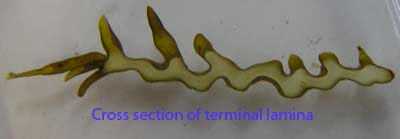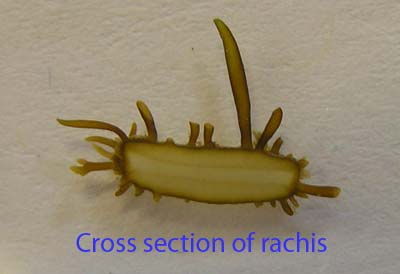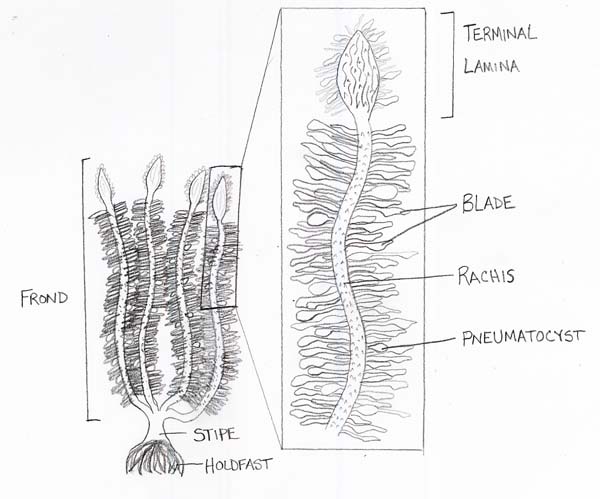
Morphology
|
|
Egregia menziesii is a perennial kelp that includes a holdfast, stipe, and fronds. The fronds are profusely branched and an individual plant typically has 4-25 fronds. In subtidal plants, each frond can grow to be 5 to 15m long(1). The holdfast is a tight ball-like anchor that is made up of numerous branches and can be up to 20cm in diameter(1). The stipe is thick and the fronds branch off from it. Each frond consists of a thick, strong central axis called a rachis. The rachis is laterally lined with blades and pneumatocysts and terminates at the terminal lamina. The terminal lamina is not as thick as the rachis and is wider and more rugose. Pneumatocysts are small round projections from the rachis that are air-filled and aid in floatation. The feather boa kelp grows to a size that is unusually large for its wave-exposed habitat. They can attain such large sizes because they have a very low drag coefficient(2). E. menziesii is susceptible to heat stress and desiccation during very low tides(3). However, it can recover quickly and it has a relatively fast growth rate(4). |
Both the rachis and the terminal lamina are made up of parenchyma, but both take on different shapes. As you can see, the terminal lamina is wider than the rachis, perhaps aiding in photosynthesis.



(1)Abbott, I.A. and Hollenberg, G.J. (1976). Marine algae of California. Stanford, Calif: Stanford University Press.
(2)Friedland M.T. and Denny M.W. 1995, Surviving hydrodynamic forces in a wave-swept environment: Consequences of morphology in the feather boa kelp, Egregia menziesii (Turner). Stanford University, Pacific Grove, CA. J. Exp. Mar. Bio. And Eco. 190 pgs. 109-133.
(3)Engle J.M. and Davis G.E. 1996. Ecological condition and public use of the Cabrillo National Monument intertidal zone 1990-1995. Technical report. Cabrillo Historical Assoc, Cabrillo National Monument, Point Loma, CA.
(4)Littler M.M. and Murray S.N. 1975. Impact of sewage on the distribution, abundance, and community structure of rocky intertidal macro-organisms. Mar Biol 30: 277-91
